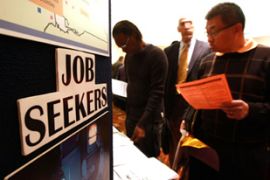Obama pushes stimulus plan
US president to hold “town hall” meetings and news conference as senate debates plan.

Al Jazeera’s Rosiland Jordan in Washington DC says Obama is taking the case for the stimulus plan directly to the US people, to show he not only understands the depth of recession but also that he understands their concerns they may not be able to take care of their families.
By making this “one-on-one” connection he is hoping these people will flood congress phone lines and persuade US legislators to pass the bill, she adds.
Congressional wrangling
The US house of representatives has already passed one form of the bill, and the senate has its own version which senators hope to approve on Tuesday after mustering the 60 votes needed.
| In depth |
 |
The senate bill has a greater emphasis on tax cuts following complaints from Republicans, while the house bill devotes more money to states, local governments and schools.
However, the two versions must be reconciled before both houses of congress can vote on – and approve – a final version.
On Monday, two senators who helped shape the senate bill said the plan was the best that could be achieved under the circumstances.
Susan Collins, from the Republican party and Ben Evans, a Democrat, said they hoped that differences between the different versions could be smoothed over, with Collins saying the senate bill was “not perfect” but that it was time for US politicians to set aside the “partisan divide”.
Bailout moves
Obama is to hold a meeting on Monday with US citizens in the town of Elkhart, Indiana, which has been badly affected by the current US economic crisis, with its unemployment rate rising sharply from 4.7 per cent to 15.3 per cent over the last year.
Later he will hold his first White House press conference at 8pm local time (01:00 GMT), before travelling to Fort Myers in Florida on Tuesday, also hit badly by the economic crisis, for a similar meeting, in a bid to convince people of the plan’s viability.
Last Friday, US employment figures showed that almost 598,000 jobs were lost in January alone, increasing the US unemployment rate to 7.6 per cent, its highest level in decades.
Meanwhile, Timothy Geithner, the US treasury secretary, has delayed the unveiling of a new bailout framework for financial institutions from Monday in order to let the administration focus on the current stimulus legislation.
Congress approved a $700 billion bailout for the financial sector late last year, however the Bush administration was heavily criticised for failing to ensure adequate transparency over how the money was spent.
On Monday, the New York Times newspaper reported that the revised plan for the remainder of the bailout would call on hedge funds, private equity funds and possibly insurance companies to buy the bad assets that wiped out many banks.
The US economy is in a recession following months of market turmoil sparked in part by the subprime mortgage crisis, in which people were given mortgage loans they could not repay, along with tight credit conditions and turmoil on global markets.